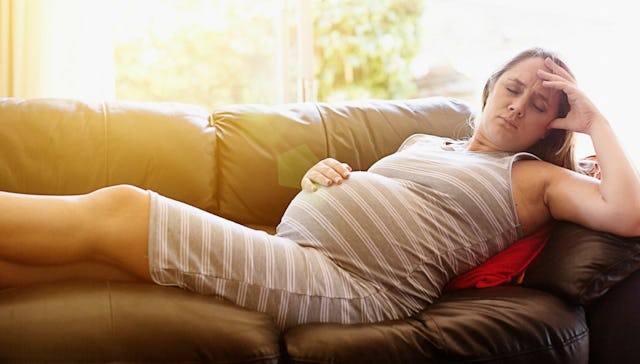Hot Weather Could Induce Early Labor

Being pregnant in the summer is the absolute worst. You’re always hot, no matter how high the air conditioner is on (much to the disappointment of anyone who lives with you). It feels like you are sweating out of literally every pore on your body, which makes for some seriously uncomfortable times. Seriously, there’s nothing as gross as pregnancy swamp crotch. And no matter how much water you drink, you’re always thirsty, which means you’re peeing every five minutes. The worst.
But did you know that on top of all that, warmer weather can also induce labor earlier?
A study from 2014, published in the journal Epidemiology found a correlation between early-term birth and extreme heat. In the study, researchers examined data from 206,929 term and 12,390 preterm single, live births between 1981 and 2010 in Montreal, Canada. Preterm is anything before 37 weeks gestation, early term is between 37-38 weeks and full term is everything over 39 weeks. Researchers looked at the highest temperature in the week before birth, and the amount of consecutive days of high temperatures that same week. Their gauge for high temperature is 32 degrees C, or 90 degrees F. Basically, pretty fucking hot.
Depending on when you give birth and where you live, these temperatures could be quite common. My son was born in late summer, but we live in Southern California, so it was still pretty freaking hot. We definitely had a heat wave in the weeks prior to his birth. During those last couple weeks I would joke that I didn’t want to see our electric bill because I pretty much kept the air conditioner on all the time. No one else in the house was as hot as I was. As much as I tried to stay inside, I still needed fresh air now and I had to go outside, even if it was only to walk the dog.
When you’re at the end of your pregnancy, you really don’t want to have to do more than the bare minimum. This is about a million times more true if you’re pregnant in summer (again, swamp crotch isn’t fun when you can’t see your vagina.) Just walking outside to check the mail can make you need a nap. Let alone having to actually do things. And let’s face it, it’s practically impossible to not do anything in those last few weeks. That’s usually when we’re trying to tie up loose ends before the baby arrives.
My son was born 15 days before his due date. I was 37 weeks and 5 days pregnant. Technically I was in that early term birth group. On the day he was born, it had been in the 80s. Obviously I spent most of that day inside my apartment with the air conditioning on while I made my way through contractions. But I remember it still be fairly warm when we went to the hospital in the late afternoon. I put on a dress, not just because it was the easiest thing to slip on as I was doubled over in pain, but because it was coolest thing I had.
According to the study’s findings, the chance of delivery was 4% higher when the temperature high was 90 degrees or higher. And this was mostly with an early term birth like mine, versus a full term. Risk of early term birth was 27% higher if there was a heat wave (high temperatures lasting four to seven days) in the week prior to delivery.
“Pregnancy becomes more physically challenging as you get closer to term,” author of the study, Nathalie Auger, MD, MSc, researcher at the University of Montreal’s department of social and preventive medicine, tells Parents.
And it’s true. As your belly drops and the baby begins to descend down the birth canal, walking becomes incredibly difficult. Sometimes just being able to sit upright and breathe is physically taxing. You’re definitely not moving as fast. This is probably tenfold when it’s damn near 90 degrees outside. Thankfully, where I live, there is no humidity. Being practically full term and having to deal with heat and humidity? That’s a hell no, thank you very much.
“Physical stresses—like heat—have a greater impact at 37 or 38 weeks, than earlier in your pregnancy,” Dr. Auger adds. While the research isn’t saying that high temperatures alone are causing early term labor, the correlation between the two is hard to deny.
Giving birth between 37 and 40 weeks isn’t quite as dangerous as giving birth before 37 weeks, but there are still risks, as the fetus is still developing in those last weeks of pregnancy.
For many pregnant women, staying inside where it’s cool isn’t always the easiest thing to do. At the end of my pregnancy, I had a lot of errands and appointments to take care of. And since I don’t drive, I was doing a lot of it on public transportation. Moms who have to work until they’re close to their due date may not have that luxury either. And we all know that moms who have other kids can’t spend the entire end of their pregnancy hiding in the A/C.
If you must be outside in the extreme heat for whatever reasons, Dr. Auger reminds that you need to be drinking as much water as possible. Even if you don’t feel thirsty, drink anyway. Feeling thirsty, especially extremely thirsty, can be a sign of dehydration. And dehydration can also induce labor.
Sadly, there is no way to be truly comfortable when you’re pregnant in the summer. But by staying as cool and hydrated as you can, you just might impact when your baby arrives.
This article was originally published on